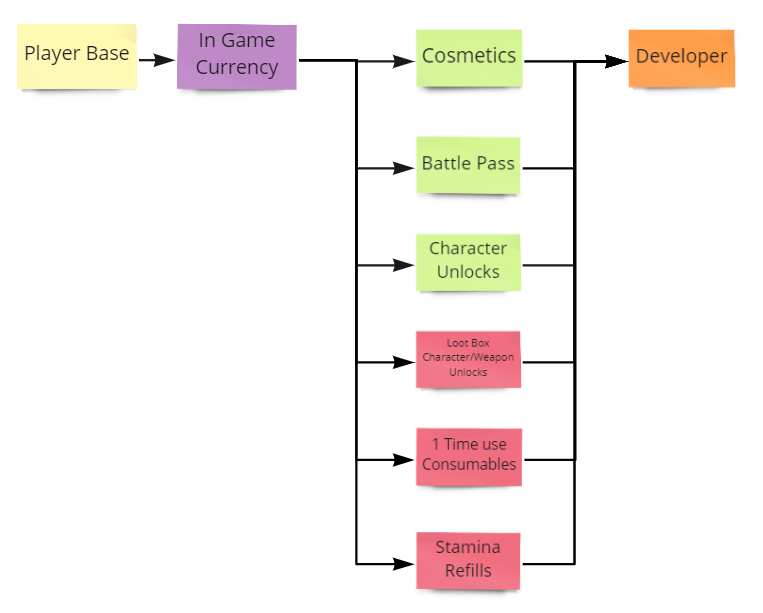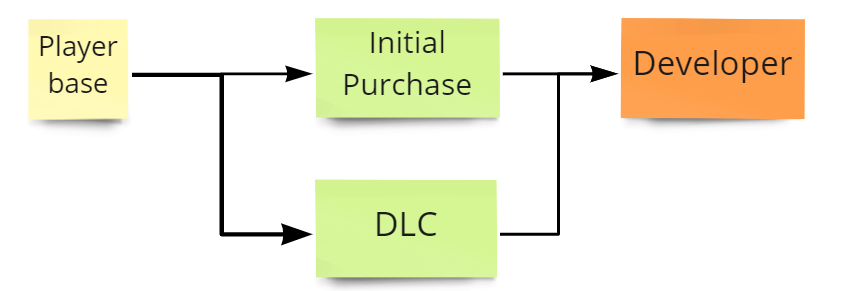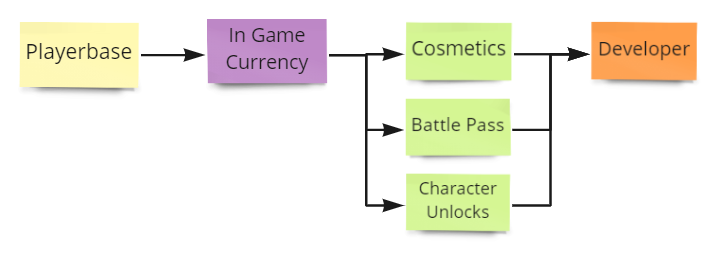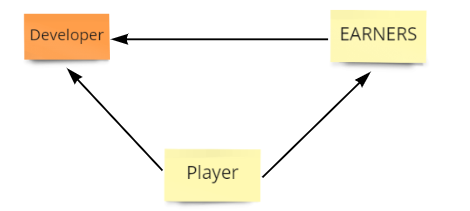Play: State of Monetization (Part 1)
Before we begin discussing the goals that we are aiming to achieve and the changes that we have implemented with PLAY & EARN gaming at SIPHER, we will take some time to explore the current state of monetization within traditional games.
Note: The original publication date of this article was February 21, 2022.

Let’s start by examining the PC and the mobile gaming industry, and how game developers have been using different methods to monetize their games. It is crucial that we reflect upon these methods to identify the areas that we should avoid and the methods that we can consider implementing within the SIPHER Game Economy.
PC and Mobile Gaming
The Main Principle: As of now, the prevailing model for all PC and Mobile Games follows a monetization method that is single-sided. This means that money flows entirely in ONE DIRECTION: from PLAYERS to DEVELOPERS. In practice, the PLAYERS get entertainment from the DEVELOPERS, while DEVELOPERS receive money from the PLAYERS.
PC Monetization
For the most part, monetization in PC games is fairly straightforward. They typically fall into two large categories of monetization:
1. SINGLE PURCHASE GAMES + DLC
Considered to be the Traditional Gaming Model. The player makes an initial purchase, which is paid to the developer. Any additional content comes in the form of Downloadable Content (DLC), which is sold by the developer and must be purchased by the player to gain access. There are no microtransactions (MTX) involved in this process.

2. GAMES AS A SERVICE (GAAS)
This type of monetization method relies on MTX, whereby the player purchases an in-game “premium” currency and uses it within an in-game “store” to purchase cosmetics, battle passes, character skins, skills, etc.
One thing to note about GAAS games on PC is that the concept almost always never directly interferes with the gameplay itself.
3. HYBRID MODEL
This model is a mixture of the two models described above. There have been instances in which Triple-A (AAA) games sold their game (initial purchase) upfront and then charged MTX.

Mobile game monetization
Mobile games currently utilize most, if not all, of the possible monetization methods, and are much less concerned about inciting negative feedback from their community. While some games avoid an outright Pay-to-Win (P2W) model, many games encourage a “Pay-2-Keep up” model.
Mobile Gaming Analysis
Mobile games are able to get away with much more monetization of their games. They are able to have all of the PC monetization methods (Single Purchase + DLC, GAAS, Hybrid, you name it).
Additionally, their currency can be used for many more purchases, with the developers actively pushing for those use cases. Some examples include:
- An extra life upon death
- Adding a wait time to their game so that players can pay to skip it
- Stamina system for playing the game — so that players need to pay for stamina refills — and to further slow down the player progression and monetize on “catch-up” bonuses.
- Out-of-game consumables that confer an in-game buff.
A big part of mobile monetization is utilizing the “power creep” method as part of the game’s content rollout. For instance, developers could release newer heroes (characters) that are “ever so slightly” stronger than their previous counterparts. Later on, these older heroes can become underpowered to the point that players would want to purchase these newer heroes.
This is also frequently complemented with a loot box mechanic, which can be combined with the “premium” in-game currency. This makes it very hard for the players to determine the proper “real-life” value of certain heroes or weapons and leverages the gambler’s fallacy to encourage people to spend more on In-App Purchases (IAPs).
But once again, money only flows from the PLAYER to the DEVELOPER.
“Play” To Earn, the Current Space
The Main Principle: Ignoring PLAYERS and only worrying about your game’s Potential ROI is the fastest way to make all of the players leave your game in a year or two.
The important thing to remember is that PLAYERS lead the way. Whichever game they decide to play, EARNERS will join to profit off of them. We have to make a game that focuses on maximizing the number and retention of PLAYERS. Only then is when we can guarantee stability and profits for ALL of our EARNERS.
Analysis on Play-to-Earn (P2E)
With this relatively new concept of P2E games, the monetization flow has been flipped around. Now there’s another party extracting money from this economy. Let’s refer to them as the EARNERS. EARNERS are individuals who play the game or are involved in the game’s ecosystem in order to generate profits, and their enjoyment of the game is considered secondary. For a lot of EARNERS, this P2E game is their livelihood. They need consistent income from this game. In an ideal loop, the Monetization flow would look something like this.

On paper, it’s great that now EARNERS can generate profits in addition to DEVELOPERS. But this is where most of the games in the P2E space make the same mistake.
The Problem with P2E: Prioritizing Earners, Forgetting about Players
Many developers in this space tend to focus their efforts on creating the most profitable game for earners, onboarding more individuals to become earners and make money through their game, and proving that their game has the highest ROI.
This leads to an emphasis on the ‘EARN’ in P2E rather than the ‘PLAY’ and leads to the creation of a game that is not necessarily fun or entertaining. Most importantly, it ends up being a game that most likely would not be played if there was no monetary return.
Rather than thriving on a three-way economy, as shown in the graph above, the game ends up with a two-way economy that consists of EARNERS and DEVELOPERS. Additionally, this ends with a problem in which EARNERS that joined the game earlier tend to be the ones that profit most from future earners, and future earners tend to invest with the hopes that they can turn a profit from those that join after them.
Sounds familiar? Yeah, this is pretty much the definition of a Pyramid Scheme.
If your game relies on onboarding new players, who pay the old players, and wait for newer players so that they can turn a profit, it is a wholly unsustainable model that only benefits those who were early, and only in the short term.

Eventually, the P2E game reaches a growth plateau, typically followed by an excess of supply and low demand, and then the game slowly dies due to asset value ends up hitting rock-bottom, resulting in a lack of return for those that play the game (primarily EARNERS).
Conclusion
In Conclusion: “EARNER ONLY” ECONOMIES DO NOT WORK
Now for the important question: Knowing the common shortfalls of the current P2E Space, how does SIPHER plan to combat these issues?
The next article in the series will cover the answer to this question. We will also take a look at how the different game entities within Sipher will interact with one another, how earners and developers can profit from players, how players reap enjoyment and progress from both earners and developers alike, and how all of this wraps up into a functional ecosystem.
Check it out here:
SIPHER’s Three-Party Economy (Part 2)
Thank you! ♥
Sipher Website: https://sipher.xyz
Sipher Links: https://linktr.ee/sipherxyz
We are actively hiring! If you ♥ gaming and making great games, Join us at Sipher: https://careers.sipher.xyz/
Play: State of Monetization (Part 1) was originally published in SIPHER on Medium, where people are continuing the conversation by highlighting and responding to this story.



0 Comments
Recommended Comments
There are no comments to display.